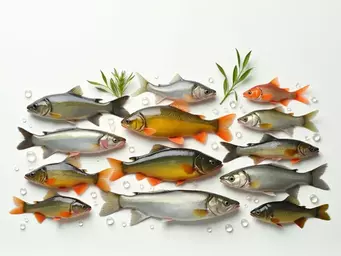Consumption Trends
Nigeria & Ghana
NG Nigeria: ~3.5M Metric Tons by 2025
GH Ghana: ~1M Metric Tons by 2025
*Driven by urbanization & preferences
Unlock strategic insights and practical guidance for your aquaculture venture. Join our community of thriving fish farmers!
Posted on: 2025-08-29
By: Kwame Adom
Considering that fish is an essential part of countless African diets, have you thought about how your involvement in aquaculture could transform local communities? With the growing demand for fish, there are immense opportunities ahead for aspiring farmers.
An overview of projected fish consumption and production growth in key African countries.
NG Nigeria: ~3.5M Metric Tons by 2025
GH Ghana: ~1M Metric Tons by 2025
*Driven by urbanization & preferences
KE Kenya: ~12% Annual Aquaculture Growth
ZA South Africa: ~10% Annual Production Increase
*Innovations & government support
NG Nigeria: >$2 Billion by 2025
GH Ghana: Strong growth, marine resources
*Global market positioning
*Catering to market & health needs
As I explore the landscape of fish market demand in Africa, it's crucial to recognize the significance of fish in our diets. Fish is not just a source of protein; it plays an essential role in the nutritional security of countless families across the continent. In many African cultures, fish is intertwined with tradition and community, contributing to both health and economic stability.
The dietary preferences in various regions highlight the importance of fish as a staple food. Countries like Nigeria, Ghana, Kenya, and South Africa exhibit a growing reliance on fish, which reflects a shift towards healthier eating habits. Have you ever considered how this shift could impact local fish farming initiatives?
In many African households, fish is a vital protein source, especially in coastal and riverine communities. Here are some key reasons why fish is significant in our diets:
Recognizing these factors can help budding fish farmers like you understand the market's needs better. By addressing nutritional demands, we can create products that resonate with consumers.
The fish market in Africa is witnessing significant demand shifts. In Nigeria, for example, the consumption of fish has increased dramatically due to urbanization and changing dietary habits. In Ghana, there's a rising interest in sustainable fishing practices that cater to local tastes. Kenya and South Africa are similarly investing in aquaculture to meet growing needs.
It's exciting to see how these trends evolve! Understanding them can position you to make informed decisions in your fish farming ventures.
Let’s dive deeper into the variety of fish species popular in these countries. Each species offers unique nutritional benefits and market potential:
By focusing on these local species, you not only cater to market demand but also promote healthier dietary options for your community. Remember, the more we understand our fish varieties, the better we can tailor our farming practices to meet consumer needs!
Fish is a vital protein source, rich in omega-3 fatty acids, vitamins, and minerals. It also holds significant cultural importance in many African communities and contributes to nutritional security and economic stability.
Nigeria, Ghana, Kenya, and South Africa are seeing notable shifts in fish consumption, primarily driven by urbanization and changing dietary preferences towards healthier protein sources.
Popular local species include Tilapia (mild flavor, adaptable), Catfish (rich in protein and omega-3), Mackerel (high in healthy fats), and Sardines (affordable and nutritious). Focusing on these species helps meet local demand and promote healthier diets.
Nigeria's fish consumption is projected to reach approximately 3.5 million metric tons by 2025, while Ghana aims for about 1 million metric tons by the same year. Both countries show increasing reliance on aquaculture to meet demand.
Kenya's aquaculture sector is growing at an annual rate of about 12% due to innovations and government support. South Africa expects a 10% annual increase in fish production, focusing on both domestic and export markets. For a broader perspective on global agricultural trends, including fisheries, consult the OECD-FAO Agricultural Outlook 2023-2032.
Nigeria's fish export revenues are projected to exceed $2 billion by 2025. Ghana also anticipates strong growth in fish exports, leveraging its rich marine resources. Kenya and South Africa are enhancing their global market positions through sustainable practices and quality improvements.
Yes, there is a growing recognition of the need for innovative policies to support the African fisheries and aquaculture sector, as highlighted by discussions on platforms like Farming First, which advocate for sustainable growth and development.
What do you think about the rising demand for fish in Africa? How do you see it impacting local communities and farmers? Share your thoughts below:
Understanding the market size and growth forecasts for fish consumption in Nigeria, Ghana, Kenya, and South Africa is essential for anyone looking to dive into the lucrative aquaculture business. As I’ve observed over my years in the industry, each country has its unique dynamics and potential that can be harnessed by aspiring fish farmers. Let’s explore the projected patterns and growth rates that can guide our strategies in the fish farming sector!
For instance, factors like population growth, urbanization, and rising incomes greatly influence the demand for fish. As people increasingly seek healthy protein sources, fish stands out as a top choice, making it crucial for us to understand these trends.
In Nigeria and Ghana, fish consumption is on the rise due to cultural preferences and dietary needs. Here’s a brief overview of what to expect:
These trends highlight the vast opportunities for fish farmers in both countries to meet local demands. Crafting your business strategies with these projections in mind could lead to substantial growth!
Moving on to Kenya and South Africa, the growth rates in fish production are promising. Let’s break it down:
This growth presents an exciting landscape for local farmers. By tapping into this market, we can not only contribute to food security but also bolster our economic standing!
The economic impact of fish exports from these countries cannot be overstated. As a fish farming community, we need to keep a close eye on how these trends evolve. Here are some key points:
These forecasts paint an optimistic picture for those of us in the aquaculture industry. With the right approach, we can not only meet local demands but also position ourselves as competitive players in the global market!
Here is a quick recap of the important points discussed in the article:



 The future of aquaculture in Africa is brimming with opportunities, driven by innovation and sustain
The future of aquaculture in Africa is brimming with opportunities, driven by innovation and sustain
 The increasing demand for fish protein in Africa is creating a wealth of opportunities for aspiring
The increasing demand for fish protein in Africa is creating a wealth of opportunities for aspiring
 As the demand for fish continues to rise, Ghana's aquaculture sector presents a wealth of opportunit
As the demand for fish continues to rise, Ghana's aquaculture sector presents a wealth of opportunit